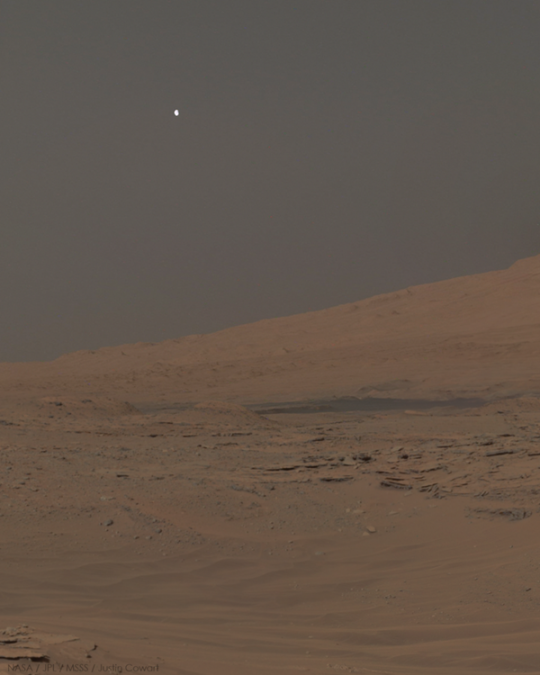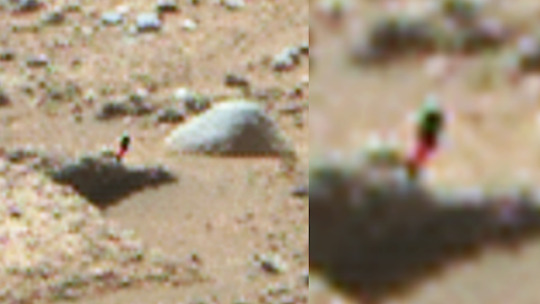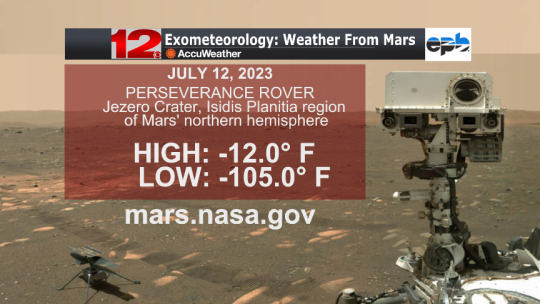#mars2020
Note
Ayo has NASA ever shown any pics of Mars moons in it's sky? I NEED TO KNOW
a couple asks ago i showed an example of this. here’s a few more:

annular solar eclipse/transit of Phobos across the Sun from Curiosity.

transit of Deimos across the Sun from Curiosity.

Occultation of Deimos by Phobos as seen by Curiosity.
The telephoto cameras used for navigation on Mars are also capable of being used as weak telescopes. (I do not know how they safely get photos of the Sun, though. Even at Mars distance that would still fry the sensors--so i assume they must have put a solar filter on the instrument specifically for this use case.)
While looking for images I came across this really cool one from Spirit:

The bright moon-like glow is Phobos. The dimmer dot is Deimos. Towards the bottom of the image is the Hyades cluster, and the bright star Aldeberan. In the lower left is the Pleiades cluster. This is an approximately naked eye-like view (well, maybe 2x or 3x magnification), except that with the naked eye Phobos would not look overexposed.This is really striking to me because this actually feels like a view of the night sky on Earth, yet with alien moons. Really cool.
Here’s a labelled, overexposed version:

I don’t think there’s been any color pictures of this done because Mars rovers are not astronomical observatories and because there’s not much color detail actually visible in the moons. And I assume aside from the solar eclipse pictures these images were all taken at night, with pitch-black skies and nearly black horizons.

This evening or afternoon image depicting Phobos as seen by Curiosity is a composite image--Phobos is probably much brighter here than it would really look during the day on Mars.

Deimos is visible in this poorly white-balanced shot of Mars from Perseverence. The sky is green here but Mars’ sky is really more of a yellow or brown color.

Here is almost the reverse--seen from an orbiting satellite, here is Phobos against the limb (edge of the visible disk; horizon) of Mars. I believe terrain looks weirdly flattened and a little distorted here due to lensing from Mars’ atmosphere--you can see how the effect gets worse closer to the limb. A similar effect, but more significant, can happen when looking at the limb of the Earth from space. Space probes use multiple color filters to take color photos, but when it comes to fast moving targets it’s not possible to switch colors in time, which is why this image is in grayscale. Notice also how dark Phobos is--it’s almost black. It only appears bright against the even blacker space. This is also true of the Moon, incidentally, but the effect is even more pronounced with Phobos.
9 notes
·
View notes
Text


Ingenuity hopping around on Mars
#nasa#space#science#spaceflight#engineering#spacecraft#technology#aerospace#mars#nasa mars#mars2020#nasa ingenuity#ingenuity#nasa perseverance#aircraft#helicopter#fly#flying#gif#dank memes
62 notes
·
View notes
Text
Art for a beloved helicopter

though you may fly no more, in our hearts you still soar
(made on the day of the loss of contact, Jan 25, just uploading late)
3 notes
·
View notes
Video
Mars2020 - Sol 670 - Mastcam-Z by Kevin Gill
Via Flickr:
Decorrelated color. NASA/JPL-Caltech/ASU/Kevin M. Gill
0 notes
Photo

Being a NASA/JPL Solar System Ambassador has its perks. Not only do I get to talk to kids about space science, but I also get some cool mission shirts! The Perseverance Rover is currently collecting samples of Martian rock and soil. Soon, it will be dropping off some collection tubes at a point called Three Forks Sample Depot. In the near future, the Mars Sample Recovery Mission will pick up the Martian samples and bring them back to Earth for analysis. #explorepage #nasa #perseverance #mars2020 #lifeonmars #marssamplereturn #jpl https://www.instagram.com/p/Ck44siYuh2V/?igshid=NGJjMDIxMWI=
1 note
·
View note
Video
youtube
Stunning Mars Discovery by NASA: Hard to Believe, but True! Hindi
#youtube#Curiosity Rover Mars2020 Perseverance Rover Ingenuity Helicopter NASA Insight Martian Atmosphere Alien life SpaceX Elon Musk Colonize Mars
0 notes
Video
youtube
🌚 What does Mars sound like?! 🌝 Singing Planets 🚀 #Shorts 🚀 🌓 Solar Sys...
What does Mars sound like?! #Shorts
Lyrics:
What does Mars sound like?!
What does Mars sound like?!
«Who knows? Who knows?»
So they all rolled over and one planet said:
- «Shh!!!»
Link to full serie "What does Space sound like?!": https://youtu.be/BbuSUk8fK8U
************************************************************************************************
👶 👦 👧 Dear children and their parents! 👩 👨 👴 👵
Listen, sing, dance and fingerplay funny traditional English language folk songs with Singing Planets on YouTube!
Subscribe: https://www.youtube.com/channel/UCwYlUPSZFUMbcSDZw6km3jw?view_as=subscriber?sub_confirmation=1
Follow us!
Singing Planets on facebook: https://web.facebook.com/kids.youtube.tv/
Singing Planets on Vk: https://vk.com/kids__tv
Singing Planets on SoundCloud: https://soundcloud.com/kids_tv
Singing Planets on twitter: https://twitter.com/KidsTV87311154
Singing Planets on Instagram: https://www.instagram.com/kids_youtube_tv/
Singing Planets on Ok: https://ok.ru/group/54144789905543
Singing Planets on blogger: https://kidstv-1.blogspot.com/
Singing Planets on Google: https://singing-planets.business.site/
© All rights reserved. Singing Planets 🌎
#whatdoesmarssoundlike #singingplanets #shorts #solarsystem #nurseryrhymessong #whocanhelptosavetheearth #stayathome #washyourhands #nursery #nurseryrhymessongsforkids #space #astronauts #solarsystemsong
#youtube#mars nasa space science marssound perseverance perseverancerover solarsystem mars2020 planets news marsrover rover redplanet nasarover marti
0 notes
Text




VIDA EN MARTE: UNA REALIDAD INCÓMODA
El planeta Marte tuvo regiones habitables al mismo tiempo que la vida se originó en la Tierra. La noticia es un bombazo. Pero, ¿qué significa habitable? ¿Hubo vida marciana? El análisis de los datos obtenidos hasta hoy ofrecen una verdad incómoda para muchos, pues van en sentido opuesto a la idea de que el planeta rojo albergara vida.
La exploración de Marte, desde la sonda Viking en 1976 hasta la actual misión Mars2020 y su rover Perseverance, ofrece una imagen del planeta que resulta muy familiar. Sus volcanes, deltas de antiguos ríos y lechos de lagos desecados evocan nuestro propio planeta, con un pasado activo y, quizá, vivo.
El parecido geológico de Marte con lugares como Lanzarote o Islandia está confirmado y los análisis detallados de las rocas y minerales del planeta rojo demuestran que Marte tuvo abundante agua en el pasado remoto. La palabra "vida" se repite tras cada noticia de las misiones de exploración. Pero ¿cuales son las evidencias de vida actuales? Y hablamos de la vida tal como la conocemos.
El rover Perseverance aterrizó en un lugar elegido cuidadosamente: el cráter Jezero, resultado de un impacto ocurrido hace entre 3700 y 4000 millones de años. Jezero albergó un lago en el que desembocaba un canal fluvial que dejó un delta en forma de abanico. Era el sitio perfecto para buscar evidencias de vida.
En Noviembre de 2022, Perseverance encontró conglomerados de cantos rodados que indican una corriente de agua constante.
El análisis de las rocas muestra evidencia de minerales secundarios formados por la acción del agua sobre las rocas ígneas. La alteración de los olivinos y la formación de carbonatos, yesos y arcilla en el viejo cráter marciano se produjo de la misma forma en la Tierra. El proceso, además, ocurrió justo en la época en la que la vida surgió en nuestro planeta. Claramente, Marte tuvo regiones habitables.
Habitabilidad, en el sentido astrobiológico, significa que un planeta tuvo las condiciones para el origen de la vida: temperatura, ambiente, geoquímica y presencia de agua líquida. Sin embargo, es importante remarcar que habitabilidad y presencia de agua líquida no implican vida. Que en Marte hubiera ríos y lagos, ni prueba, ni sugiere que la vida se haya originado allí.
Otro hallazgo reciente del rover Perseverance es la presencia de materia orgánica asociada a las rocas alteradas por el agua.
De nuevo, la idea es sugerente por su similitud con la Tierra: sedimentos con arcillas y carbonatos que contienen materia orgánica. ¿Es una evidencia de vida? Por el momento, no. Los datos indican que las pequeñísimas cantidades de materia orgánica detectada pertenecen a un tipo de compuestos llamados aromáticos. Un ejemplo de estos compuestos es la naftalina, y los compuestos aromáticos pueden tener origen abiótico. De hecho, hemos demostrado que una amplia variedad de estas sustancias pueden generarse, incluso a bajas temperaturas, a partir de metano. Como ocurre con el agua, la presencia de materia orgánica no implica vida. Por ahora, no se han encontrado biomarcadores, es decir, sustancias orgánicas cuya presencia solo puede explicarse mediante la actividad de organismos vivos. Todos los hallazgos de materia orgánica en Marte son explicables por procesos geoquímicos.
A pesar de que hay cierta tendencia a que las noticias que se publican sobre Marte sean sensacionalistas o ambiguas (una ambigüedad promovida a veces por los científicos), los datos, por ahora, van en sentido opuesto a la idea de que hubo vida en ese planeta.
Si, Marte pudo ser habitable, pero no hay evidencias de que la vida se haya originado allí. No hay ni compuestos orgánicos que puedan interpretarse como biomarcadores, ni huellas geoquímicas o mineralógicas de actividad de seres vivos.
El estudio de la geología del cráter Jezero sugiere, además, que el lago de unos 45 km de diámetro, que existió hasta hace unos 3700 millones de años, pudo tener una duración muy corta. Ello no favoreció la formación de sedimentos lacustres, prácticamente inexistentes, ni la alteración de las rocas. Todo esto tampoco juega a favor de la evolución de la vida.
Una gran baza para hallar huellas de vida en Marte son los minerales. Los procesos biológicos alteran los minerales de un modo particular, dejando diversas biofirmas características, tales como combinaciones de especies minerales o cambios en la proporción de los isótopos estables de elementos como el azufre o el carbono. Aún no se han hallado esas biofirmas.
Hay un tipo de mineral que pasa inadvertido, pero es clave para el origen y evolución de la vida: los fosfatos. Los datos que tenemos hasta ahora de Marte sugieren que los fosfatos están ampliamente dispersos en las rocas ígneas y son de tipo primario. No hay evidencia de movilización del fosfato, formación de fosfato secundario o su acumulación, resultado de la acción de organismos vivos o de procesos prebióticos activos.
En conjunto, no tenemos evidencias de vida en Marte. Ello no implica directamente que no la hubiera, tan solo que el misterio continúa. Pero, si aceptásemos la hipótesis de que nunca hubo vida en Marte, lo que vamos encontrando encaja con ella.
Aún queda mucho por explorar. Por ejemplo, cuando las muestras recogidas por Perseverance viajen a la Tierra se hará un análisis detallado que puede darnos sorpresas.
De haber existido vida en Marte, debió ser primordial y probablemente se extinguió hace más de 3000 millones de años. Esta idea se ha sugerido recientemente en un modelo teórico basado en la evolución del clima marciano y la presencia de organismos con un metabolismo similar al que pudieron tener las primeras células en la Tierra.
Hay una posibilidad muy remota de que la vida se mantuviera en el subsuelo, sostenida por la energía de la actividad magmática que, aún hoy día, se mantiene en el planeta.
Si Marte no tuvo vida, ¿merece la pena explorarlo? Sin duda: la exploración espacial tiene muchos beneficios, tanto en conocimiento como para el avance tecnológico.
Las grandes cuestiones de la astrobiología siguen abiertas y solo hemos explorado una parte mínima. Paradójicamente, que Marte nunca tuviera vida puede enseñarnos mucho sobre nuestro propio origen. Y si sí la tuvo, será uno de los mayores descubrimientos de la Humanidad. En ambos casos, ganamos.
10 notes
·
View notes
Note
You know of any good digital terrain/elevation models for Jezero? I'm bored and want to 3d print some ground.
Happily, all NASA data is open source! If you're American, you're the one who paid for it, so it's your data in the first place and we've been sure to make it available to you. If not, you can have access anyway as long as you promise to experience a sense of wonder at the vastness of the cosmos and a degree of vertigo in realizing that Mars is actually, really a place, not just an object of fiction or myth, and that you can actually, really go there.
Broadly speaking, most of NASA's (surface) data is stored on the PDS, or Planetary Data System, and you should feel free to google around and grab whatever you like from its many many libraries. It has sub-modules for various planets and such. For Mars, there's a number of different data types; the best directly 3D data we have is from MOLA, which samples every few hundred meters using a laser altimeter. For visual data such as the satellite photos I sometimes post here, the 'state of the art' right now is the CTX satellite data, which is captured at 6 meters per pixel and includes almost all of the planetary surface. You can get even better- HiRISE has 25 cm/pixel- but not if you want global coverage.
As it happens, I can get you terrain data and DEMs in near-CTX and near-HiRISE resolution, because clever people at NASA-Ames have worked out some software that lets them compare two images of the same region as a stereo pair (the same way your eyes get 3D data for your brain). So for select bits of Mars that are of special interest, such as Jezero, we can do quite well. Here's the high-resolution CTX DTM (in jpg and tiff form) that they used to make sure the landing site for the rover was clear; it includes most of the interesting geological features:
https://astrogeology.usgs.gov/search/map/Mars/Mars2020/JEZ_ctx_B_soc_008_DTM_MOLAtopography_DeltaGeoid_20m_Eqc_latTs0_lon0
And the higher resolution HiRISE DTM, which plays a role in helping Perseverance avoid hazards (it covers about the same area, so file size is getting rather large):
https://astrogeology.usgs.gov/search/map/Mars/Mars2020/JEZ_hirise_soc_006_DTM_MOLAtopography_DeltaGeoid_1m_Eqc_latTs0_lon0_blend40
This particular portal isn't scientific-grade; it's not georeferenced or pyramidized or anything like that. But I expect it's ideal for recreational use if you want to use the same data that was deployed in mission-critical situation. If you'd like the raw stuff, just let me know.

8 notes
·
View notes
Text
Plant Grows From Rock On Latest Mars Photo! UFO Sighting News. Video, please subscribe to my channel for more.
Date of discovery: April 5, 2023
Location of discovery: Mars
Source photo: https://mars.nasa.gov/mars2020/multimedia/raw-images/ZR0_0754_0733878091_081EBY_N0371798ZCAM08760_1100LMJ

I found this pink and green plant growing from a rock on Mars, its one of the latest Mars Perseverance rover photos so its 100% news stuff. I have reported a white rose on Mars I found back in 2020, but this one being two colors and close up is just mind-blowing. Now you know why NASA puts most photos into false-color. To hide the truth from the public. 100% proof that life exists on planet Mars right now!
youtube
Scott C. Waring - Taiwan

3 notes
·
View notes
Video
youtube
NASA’s Perseverance Studying Rocks - #marsexploration #travel
After 1,000 Martian days of exploration, NASA’s Perseverance rover is studying rocks that show several eras in the history of a river delta billions of years old. Scientists are investigating this region of Mars, known as Jezero Crater, to see if they can find evidence of ancient life recorded in the rocks. Perseverance project scientist Ken Farley provides a guided tour of a richly detailed panorama of the rover’s location in November 2023, taken by the Mastcam-Z instrument. Composed of 993 individual images and 2.38 billion pixels, this 360-degree mosaic looks in all directions from a location the rover science team calls “Airey Hill.” Portions of the rover itself are visible in the scene, appearing more distorted toward the edges as a result of the image processing.
A color enhancement applied to the image increases contrast and accentuates color differences. By approximating what the scene would look like under Earth-like lighting conditions, the adjustment allows mission scientists to use their everyday experience to interpret the landscape. The view on Mars would be darker and more reddish. The panorama can be explored and downloaded at: https://go.nasa.gov/3tmJnGB. Learn more about Perseverance: https://mars.nasa.gov/mars2020. Thanks for watching, don't forget to subscribe and hit the bell to stay updated when we're putting out new content for you. You can download your FREE Guide: "The Budget Traveler's Handbook" and get cheap flights, cheap hotels, cheap destinations, cheap car rentals, cheap traveler insurance at: https://TravelingFevah.com #mars #nasa #traveling Credit: NASA/JPL-Caltech/ASU/MSSS; ESA/DLR/FU-Berlin less
0 notes
Link
3 min readPreparations for Next Moonwalk Simulations Underway (and Underwater) NASA’s Perseverance puts its robotic arm to work around a rocky outcrop called “Skinner Ridge” in a set of images captured in June and July 2022 by the rover’s Mastcam-Z camera system. SHERLOC is mounted on the end of the arm.NASA/JPL-Caltech/ASU/MSSS Engineers are working to stabilize a dust cover on one of the science instrument’s cameras. Data and imagery from NASA’s Perseverance Mars rover indicate one of two covers that keep dust from accumulating on the optics of the SHERLOC instrument remains partially open. In this position, the cover interferes with science data collection operations. Mounted on the rover’s robotic arm, SHERLOC (Scanning Habitable Environments with Raman & Luminescence for Organics and Chemicals) uses cameras, a spectrometer, and a laser to search for organic compounds and minerals that have been altered in watery environments and may be signs of past microbial life. The mission determined on Jan. 6 that the cover was oriented in such a position that some of its operation modes could not successfully operate. An engineering team has been investigating to determine the root cause and possible solutions. Recently, the cover partially opened. To better understand the behavior of the cover’s motor, the team has been sending commands to the instrument that alter the amount of power being fed to it. With the cover in its current position, the instrument cannot use its laser on rock targets, and cannot collect spectroscopy data. However, imaging microscopy can still be acquired with WATSON, a color camera on SHERLOC used for taking close-up images of rock grains and surface textures. WATSON (Wide Angle Topographic Sensor for Operations and eNgineering) operates through a different aperture. SHERLOC is part of a seven-instrument suite on Perseverance. During development of the mission, the team designed the instrument suite such that the rover could still achieve its science objectives should any single instrument fail, as there is some overlap among the capabilities of the instruments. Along with SHERLOC, PIXL (Planetary Instrument for X-ray Lithochemistry) and SuperCam also perform spectroscopy. Currently making its way to explore an area nicknamed “Beehive Geyser,” the rover marked its 1,000th Martian day, or sol, on the Red Planet on Dec. 12, 2023 – more than 300 sols beyond its initial prime mission. Since the rover’s landing Feb. 18, 2021, SHERLOC has scanned and provided rich data on 34 rock targets, creating a total of 261 hyperspectral maps of those targets. Featuring a radioisotope power system, Perseverance’s design is based on the agency’s Curiosity Mars rover, which is still going strong after more than 11 years (4,000 sols) on the Red Planet. More About the Mission A key objective for Perseverance’s mission on Mars is astrobiology, including the search for signs of ancient microbial life. The rover will characterize the planet’s geology and past climate, pave the way for human exploration of the Red Planet, and be the first mission to collect and cache Martian rock and regolith. Subsequent NASA missions, in cooperation with ESA (European Space Agency), would send spacecraft to Mars to collect these sealed samples from the surface and return them to Earth for in-depth analysis. The Mars 2020 Perseverance mission is part of NASA’s Moon to Mars exploration approach, which includes Artemis missions to the Moon that will help prepare for human exploration of the Red Planet. JPL, which is managed for NASA by Caltech in Pasadena, California, built and manages operations of the Perseverance rover. For more about Perseverance: mars.nasa.gov/mars2020/ News Media Contacts Karen Fox / Alana JohnsonNASA Headquarters, Washington301-286-6284 / [email protected] / [email protected] DC AgleJet Propulsion Laboratory, Pasadena, [email protected] 2024-015 Share Details Last Updated Feb 13, 2024 Related TermsPerseverance (Rover)Jet Propulsion LaboratoryMars 2020 Explore More 7 min read JPL Workforce Update Article 7 days ago 2 min read University High School Wins Regional Science Bowl at NASA’s JPL Article 1 week ago 6 min read NASA Puts Next-Gen Exoplanet-Imaging Technology to the Test Article 2 weeks ago Keep Exploring Discover Related Topics Missions Humans in Space Climate Change Solar System
0 notes
Text

Phobos eclipses the sun, as seen from the martian surface by NASA's Perseverance Mars rover.
#goforqueuedeploy#space#spaceflight#space exploration#space science#space and astronomy#astronomy#cosmos#science#tech#technology#engineering#stem#mars#nasa#nasa perseverance#perseverance#mars2020#nasa mars#maritan#eclipse#phobos#solar system#sun#planet#moon#robots#rover#mars rover
45 notes
·
View notes
Text

Latest weather report from Jezero Crater, Mars, courtesy Perseverance Rover.
https://mars.nasa.gov/mars2020/mission/weather/
#Exometeorology#4th Rock From The Sun#Extraplanetary Weather#NASA Perseverance Rover#Weather on other planets
0 notes
Link
0 notes
Text
Happy anniversary Perseverance
Two years ago, the Mars Perseverance rover touched down.
— Read on mars.nasa.gov/mars2020/mission/highlights/
View On WordPress
0 notes